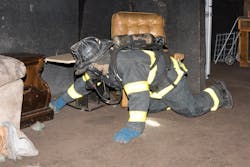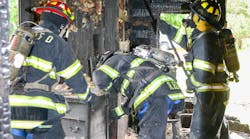The most critical—and potentially the most dangerous—task that is performed on the fireground is the primary search. Primary search might be conducted at a variety of fire incidents, from a minor fire (smoke condition caused by an overheated light ballast, wall outlet smoking, etc.) to a serious fire (an apartment with several rooms on fire in a multiple dwelling).
Search basics
When it comes to defining a primary search, the IFSTA Essentials of Fire Fighting Manual provides this description: “A rapid but thorough search performed before or during fire suppression.” Some lecturers will even use terms like “fast and furious” to describe the act. The IAFC’s Rules of Engagement for Structural Firefighting – Increasing Firefighter Survival, states the following: “Our goal as firefighters is to save lives. The fire service has a long history of aggressive search and rescue operations as an initial priority of first-arriving fire companies. History (and firefighter fatalities) also reflects that firefighters are exposed to the greatest risk of injury and death during primary search and rescue operations.”
The primary search involves many factors. The first and most important factor is the mission objective. The mission objective in a primary search is to locate victims and the seat of the fire. The objective is based on the initial size-up. Some size-up factors may include, but are not limited to:
- Known life hazard vs. potential life hazard
- Occupant accountability/survivability
- Building construction
- Size and extent of the fire
- Established water source
- Available equipment/staffing
Another vital factor that must be taken into consideration is the experience level of the individual firefighters conducting the primary search. An inexperienced firefighter may not recognize signs of imminent danger, and may search too far without the protection of a charged handline. An experienced firefighter has been down the hallway before. They may recall similar situations and avoid potential hazards. The firefighters’ mission is to save lives, not to get seriously injured or killed in the process.
When there is a known life hazard, our mission objective is very clear. The risk vs. reward factor is very high, and the aggressiveness in which we conduct our primary search is adjusted accordingly. Know that aggressiveness does not equal “fast and furious”; that approach to primary search lends itself to a firefighter missing landmarks, and possibly becoming disorientated or trapped. Searching too quickly poses the possibility of searching past victims. An aggressive search is one that is controlled, deliberate, methodical and thorough.
Primary search steps
Let’s now review some basic search techniques and methods that will aid the firefighter in conducting an effective primary search. Search techniques that are determined and deliberate ultimately reduce the risk of becoming disorientated or trapped, thereby accomplishing the mission of locating victims and locating fire.
Information-gathering is critical to formulating your primary search mission. This information comes from occupants/witnesses. Some examples: Witness states victim was last seen at the second-floor bedroom in the rear; neighbor states that the family is away on vacation; occupant states that everyone is out of the house etc.
The location and severity of fire in relationship to where victims are trapped is a key factor, as is the color, volume, velocity and density of the smoke in relationship to the point of entry. Is it possible that trapped occupants can survive with existing fire conditions?
Some other factors to consider in the information-gathering phase:
- Staffing at the scene: Will there be enough for a search team of two going interior with two firefighters outside (2 in/2 out)? Will the search team be conducting the primary search prior to having an established handline in place?
- Water source: Is there an established water source? Is the engine moving in and putting water on the fire?
- Building construction factors: Is the building woodframe, platform/balloon, fire proof/non-fire proof, residential/commercial, above grade/below grade/upper floor.
- Point of entry: Where will the crew enter—front/side door main means of egress, upper floor window, cellar entrance? Will firefighters require a ground ladder or an aerial ladder?
When these factors are evaluated, the firefighter will have a sound plan to begin their primary search.
Search position
Firefighters should search on their hands and knees. This keeps their hips and shoulders orientated in the direction of travel. If a piece of ceiling (sheetrock/plaster) falls on them or if they get hit with a water stream, the firefighter will likely keep their orientation. Another advantage of searching on all fours is that temperature is lower on the floor level. If there is a rapid change in fire conditions, the firefighter will have a better chance for survival. Further, fire victims tend to be on the floor or in beds that are all low. I have never encountered a victim levitating in the air. By crawling on all fours, it allows the firefighter to distribute their weight over a larger area, and avoid falling into burned out or compromised floors. Additionally, at the floor level, it is easier for firefighters to determine room layout. By sweeping the wall with a hand, the firefighter can feel radiators (indicative of exterior walls), door openings, windows, furniture and appliances.
During the search
The pace of your primary search should be planned and deliberate. While searching, the firefighter should pause every 8 to 10 feet or whenever they encounter a landmark (doorway, window, appliance). By pausing, the firefighter mentally gathers information that will aid in the search mission, and help them stay orientated, monitor fire conditions and make the search more productive. Each time the firefighter pauses, they should orientate themselves, recalling landmarks that were passed and take mental notes. At each pause, the firefighter should listen for six important items:
- Radio transmissions: “Engine 1 Chauffeur to Command, I have an out-of-service hydrant”; “Engine 1 Chauffeur to Command, I can’t get the rig in pump”; “Engine 1 Officer to Command, we can’t locate the fire”; “Engine 1 Officer to Command, we have a burst length”; “Engine 1 Officer to command, we have water on the fire.” Listen for any urgent transmissions—collapse feared, command requesting to go to a defensive attack, fire communicating to an exposure, etc.
- Communications with other search team members: “I’ve got another room to my right.” “I have a staircase.” “Are you OK?”
- Water application: Listening for the hose stream.
- Ventilation: Listen for the sound of windows breaking, saws operating.
- Victims: Listen for moans or cries.
- Fire: Listen for crackling.
The inside search team should always search with a complement of the following tools:
- Thermal imaging camera: A TIC is an outstanding aid in conducting a primary search. When the firefighter pauses, it is an excellent time to view the six sides of the room (four walls, ceiling and floor). The firefighter will reaffirm the room layout, will be able to monitor the fire environment (thermal contrast, convection heat energy) and locate victims.
- A 2½-gallon water can and 6-foot pike pole: The water extinguisher can help contain the fire to a room when applied at the ceiling level. The 6-foot pike pole can be used to find fire in the ceiling overhead, eliminating the risk of getting cut off from your main means of egress. It can also be used to pull a door closed isolating the fire to a room.
- Set of irons (flat head axe and Halligan tool): These tools are used for forcible entry, particularly useful in multiple dwelling fires, forcing adjacent apartment doors to create an area of refuge. The Halligan is a firefighter survival tool used to breach walls if the firefighter becomes trapped.
Practice, practice, practice
Search skills must continually be practiced. Total familiarization with your SCBA and SCBA emergency maneuvers must also be practiced. When the tones go off at 4 a.m. and the dispatcher goes over the department radio reporting a structure fire with people trapped, you must be ready, prepared and trained to do your job. Remember the key elements of a successful primary search. The firefighter must be aggressive, deliberate, controlled, methodical and thorough. Train and prepare—your life and the lives of others depend on you being ready for game day. Stay low!







